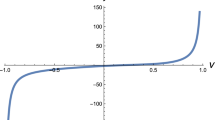Abstract
We prove that Hill's lunar problem does not possess a second analytic integral of motion, independent of the Hamiltonian. In order to obtain this result, we avoid the usual normalization in which the angular velocity ω of the rotating reference frame is put equal to unit. We construct an artificial Hamiltonian that includes an arbitrary parameter b and show that this Hamiltonian does not possess an analytic integral of motion for ω in an open interval around zero. Then, by selecting suitable values of ω, b and using the invariance of the Hamiltonian under scaling in the units of length and time, we show that the Hamiltonian of Hill's problem does not possess an integral of motion, analytically continued from the integrable two–body problem in a rotating frame.
Similar content being viewed by others
References
Arnol'd, V. I., Kozlov, V. V. and Neishtadt, A. I.: 1988, ‘Mathematical Aspects of Classical and Celestial Mechanics’, in: V. Arnol'd (ed), Dynamical Systems III, Springer-Verlag, Berlin.
Goldstein, H.: 1980, Classical Mechanics, 2nd edn., lAddison-Wesley, Reading.
Hill, G. W.: 1878, ‘Researches in the Lunar theory’, Am. J. Math. 1, 5–26, 129–147, 245–260.
Meletlidou, E. and Ichtiaroglou, S.: 1994a, ‘A Criterion for non-integrability based on Poincar´e's theorem’, Physica 71D, 261–268.
Meletlidou, E. and Ichtiaroglou, S.: 1994b, ‘On the number of isolating integrals in perturbed Hamiltonian systems with n≦ 3 degrees of freedom’, J. Phys. 27A, 3919–3926.
Oberhettinger, F.: 1973, Fourier Expansions, Academic Press, New York.
Poincaré, H.: 1892, Les Méthodes Nouvelles de la Mécanique Céleste, Vol I, Gauthier-Villars, Paris. English translation: Goroff D. L. (ed), 1993, New Methods in Celestial Mechanics, American Institute of Physics.
Spirig, F. and Waldvogel, J.: 1985, ‘The Three-Body Problem with Two Small Masses: A Singular-Perturbation Approach to the Problem of Saturn's Coorbiting Satellites’, in: V. Szebehely (ed), Stability of the Solar System and its Minor Natural and Artificial Bodies, NATO ASI Series (C): Mathematical and Physical Sciences, Vol. 154, Reidel, Dordrecht, pp. 53–63.
Szebehely, V.: 1967, Theory of Orbits, Academic Press, New York.
Whittaker, E. T.: 1944, A Treatise on the Analytical Dynamics of Particles and Rigid Bodies, 4th edn., Cambridge University Press, Cambridge.
Rights and permissions
About this article
Cite this article
Meletlidou, E., Ichtiaroglou, S. & Winterberg, F.J. Non—integrability of Hill's lunar problem. Celestial Mechanics and Dynamical Astronomy 80, 145–156 (2001). https://doi.org/10.1023/A:1011946725249
Issue Date:
DOI: https://doi.org/10.1023/A:1011946725249



